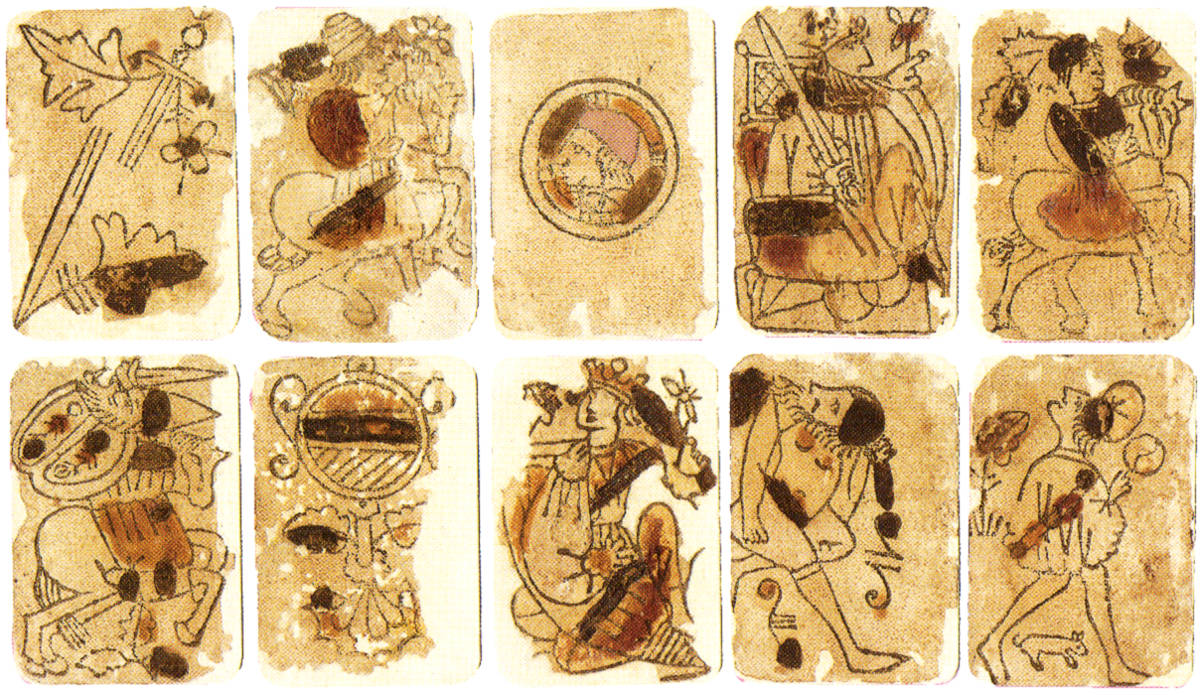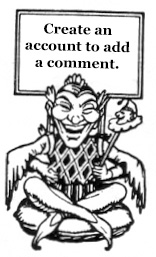The Combination of Images and Text on early playing cards
When playing cards have titles or legends these reference a written/literary tradition of some form. It connects the image to a wider cultural sphere, extending the visual impact.
The Medium is the Message
Many early playing cards had titles or legends alongside the images. These referenced a written/literary tradition of some form (historical, religious or secular literature, legends, etc), connecting the image to a wider cultural sphere, extending the visual impact. For example, French court cards were given names of heroes of antiquity, such as Caesar, Charlemagne, Paris or Lancelot, thereby connecting to the written body of French literature. This tradition goes back to the fifteenth century or even earlier. Some historians believe that court cards are actually based on these historical personages, but this is not necessarily true.

Above: cards from a primitive Latin suited pack, dated by paper analysis as “early XV century”. The cards are untitled, without any legends.

Above: four French cards designed by Jean Personne, c.1495. The cards carry inscriptions such as "Paris", "Melusine", "Conte de Chalou" and the maker's name, "Jhan Personne".

But many early cards were unnamed and unnumbered, so they were understood by card players on their own terms. If the cards are just images, with no title or legend, then the images must speak for themselves. There is no explicit reference to any text, or suggestion that the cards are based on historical persons.
The advent of printing with movable type boosted the spread of literacy and the playing card was also used as a medium to propagate the printed word.
Thus the presence of printed text or titles on playing cards adds a new level of meaning and raises their cultural status to a more rational, literate or pedagogic level; a vehicle for political or educational purposes (as well as a game of luck and skill). Today of course this might be an advertising message.

The early Arabic Mamluk cards incorporated calligraphic texts, rhyming aphorisms, evoking thoughts of a religious nature, on the court cards (inside the blue areas). But because of Islamic law, instead of images of human figures we see only abstract geometric designs on the rest of the cards. The written words transform these into sublime messengers.
“As for the present that rejoices, thy heart will soon open up“ - “I will, as pearls on a string, be lifted in the hands of kings” - “May God give thee prosperity; then thou will already have achieved thy aim” - “Rejoice for thy lasting happiness” - “Rejoice in the pleasant things and the success of the objects” - “I am as a flower, a string of pearls is my soil?” - “The alif rejoices and fulfils your wishes” - “Whosoever will call me to his happiness, he will only see joyful looks”.
These Arabic playing cards are believed to be the progenitors of playing cards in the West more →

Above: detail from the Cary Collection uncut and uncoloured sheet of tarot cards (housed in the Beinecke Rare Book and Manuscript Library, Yale University in New Haven, Connecticut) probably printed in Milan and possibly dating as early as c.1500. The images are untitled and unnumbered, suggesting that players must have already known the sequence or hierarchy of trump cards in play from contemporary knowledge.

Above: Tarot de Marseille by Jean-Baptiste Madenié, Dijon, early 18th century. The trump cards are named and numbered to designate their value during play. Images courtesy Frederic C. Detwiller.
In the case of tarot trumps the early examples are unnamed and unnumbered. Again, they were implicitly understood or memorised by the players. In some instances initial letters or monograms were added to denote a secret meaning which is often lost.

Above: the 'Sun' from the Goldschmidt tarot. The three initial letters in gothic script imply an association with a certain teaching or literary text which may have been available only to initiates, but which is now unknown. Thus a whole new level of meaning could be attributed to a simple playing card by means of a few letters.
Legends and numbers were added later to tarot trumps to denote their value or hierarchy so that a canon was established which today we take for granted. Some people believe the tarot cards are a channel for esoteric thought. There were exceptions to this: Animal Tarots and other games with non-standard trump cards did not usually have titles or metaphysical associations.
The phonetic alphabet is a unique technology which, through its uniform and sequential logic, has created civilized man, with codes of law, ledgers and ultimately, printed books. In a humble way, playing cards have participated in this development by becoming a medium for the message....


By Simon Wintle
Member since February 01, 1996
Founder and editor of the World of Playing Cards since 1996. He is a former committee member of the IPCS and was graphics editor of The Playing-Card journal for many years. He has lived at various times in Chile, England and Wales and is currently living in Extremadura, Spain. Simon's first limited edition pack of playing cards was a replica of a seventeenth century traditional English pack, which he produced from woodblocks and stencils.
Leave a Reply
Your Name
Just nowRelated Articles

Laurenzo Propagine
Spanish-suited cards made in Italy by Laurenzo Propagine.

Rouen Pattern - Portrait Rouennais
An attractive XV century French-suited design from Rouen became the standard English & Anglo-America...

Archaic Spanish proof sheets
2 x uncoloured proof sheets of archaic Spanish-suited playing cards produced for “New Spain”, possib...

Ganjifa - Playing Cards from India
Indian playing cards, known as Ganjifa, feature intricate designs with twelve suits and are traditio...

The Henry Hart Puzzle
Explore the intricate history and unique design variations of Henry Hart's playing cards, tracing th...

Sevilla 1647 reproduction
Facsimile of Spanish-suited pack produced in Sevilla, Spain, 1647.

Why our playing-cards look the way they do
Analysis of early playing card designs: origins, suit differences, standardization, technological ad...

Introduction to Collecting Themes
Playing cards can be broadly categorised into standard and non-standard designs, with collectors app...

Le Monde Primitif Tarot
Facsimile edition produced by Morena Poltronieri & Ernesto Fazioli of Museo Internazionale dei Taroc...

Pike and Clover playing cards
Pike and Clover playing cards created by Ian Cumpstey, Cumbria, UK, 2018.

Burgundy pattern - portrait bourguignon
The old Burgundy (or Burgundian) pattern by Nicolas Chenevet, Dijon.

Trappola pack by Joseph Fetscher
Trappola pack published by Joseph Fetscher, Graz, 1739.

Lyon pattern by Michel Ressy
Lyon pattern by Michel Ressy, c.1760.

Trappola pack by Anton Herrl
Trappola pack of 36 double-ended cards published by Anton Herrl, Graz, Austria.

75: Early American cards
An overview of some of the early cards made in the United States.

Moorish Deck
Review of “Trzes’ Moorish Deck” facsimile published by Ulrich Kaltenborn, Berlin, 2023.
Trending Articles
Popular articles from the past 28 days



 Your comment here. Your comment here. Your comment here. Your comment here. Your comment here. Your comment here. Your comment here. Your comment here. Your comment here. Your comment here. Your comment here. Your comment here. Your comment here. Your comment here. Your comment here. Your comment here. Your comment here. Your comment here. Your comment here. Your comment here. Your comment here. Your comment here. Your comment here. Your comment here. Your comment here. Your comment here. Your comment here. Your comment here. Your comment here. Your comment here. Your comment here. Your comment here.
Your comment here. Your comment here. Your comment here. Your comment here. Your comment here. Your comment here. Your comment here. Your comment here. Your comment here. Your comment here. Your comment here. Your comment here. Your comment here. Your comment here. Your comment here. Your comment here. Your comment here. Your comment here. Your comment here. Your comment here. Your comment here. Your comment here. Your comment here. Your comment here. Your comment here. Your comment here. Your comment here. Your comment here. Your comment here. Your comment here. Your comment here. Your comment here.